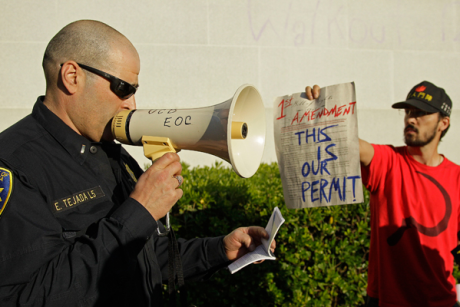Michael Gould-Wartofsky -
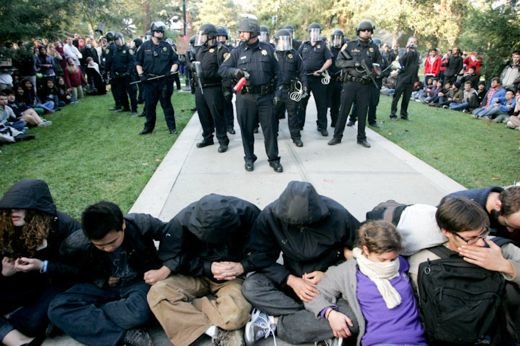 Campus spies. Pepper spray. SWAT teams. Twitter trackers. Biometrics. Student security consultants. Professors of homeland security studies. Welcome to Repress U, class of 2012.
Campus spies. Pepper spray. SWAT teams. Twitter trackers. Biometrics. Student security consultants. Professors of homeland security studies. Welcome to Repress U, class of 2012.
Since 9/11, the homeland security state has come to campus just as it has come to America's towns and cities, its places of work and its houses of worship, its public space and its cyberspace. But the age of (in)security had announced its arrival on campus with considerably less fanfare than elsewhere -- until, that is, the "less lethal (archived)" weapons were unleashed in the fall of 2011.
Today, from the City University of New York to the University of California, students increasingly find themselves on the frontlines, not of a war on terror, but of a war on "radicalism" and "extremism." Just about everyone from college administrators and educators to law enforcement personnel and corporate executives seems to have enlisted in this war effort. Increasingly, American students are in their sights.
In 2008, I laid out seven steps the Bush administration had taken to create a homeland security campus. Four years and a president later, Repress U has come a long way. In the Obama years, it has taken seven more steps to make the university safe for plutocracy. Here is a step-by-step guide to how they did it.
1. Target Occupy
Had there been no UC Davis, no Lt. John Pike, no chemical weapons wielded against peacefully protesting students, and no cameras to broadcast it all, Americans might never have known just how far the homeland security campus has come in its mission to police its students. In the old days, you might have called in the National Guard. Nowadays, all you need is an FBI-trained, federally funded, and "less lethally" armed campus police department.
The mass pepper-spraying of students at UC Davis was only the most public manifestation of a long-running campus trend in which, for officers of the peace, the pacification of student protest has become part of the job description. The weapons of choice have sometimes been blunt instruments, such as the extendable batons used to bludgeon the student body at Berkeley, Baruch, and the University of Puerto Rico. At other times, tactical officers have turned to "less-lethal" munitions, like the CS gas, beanbag rounds, and pepper pellets fired into crowds at Occupy protests across the University of California system this past winter.
Yet for everything we see of the homeland security campus, there is a good deal more that we miss. Behind the riot suits, the baton strikes, and the pepper-spray cannons stands a sprawling infrastructure made possible by multimillion-dollar federal grants, "memoranda of understanding" and "mutual aid" agreements among law enforcement agencies, counter-terrorism training, an FBI-sponsored "Academic Alliance," and 103 Joint Terrorism Task Forces (which provide "one-stop shopping" for counterterrorism operations to more than 50 federal and 600 state and local agencies).
"We have to go where terrorism takes us, so we often have to go onto campuses," FBI Special Agent Jennifer Gant told Campus Safety Magazine in an interview last year. To that end, campus administrators and campus police chiefs are now known to coordinate their operations with Department of Homeland Security (DHS) "special advisors," FBI "campus liaison agents (Archived)," an FBI-led National Security Advisory Board, and a Federal Law Enforcement Training Center, which instructs local law enforcement in everything from "physical techniques" to "behavioral science." More than half of campus police forces already have "intelligence-sharing agreements" with these and other government agencies in place.
2. Get a SWAT team
Since 2007, campus police forces have decisively escalated their tactics, expanded their arsenals, and trained ever more of their officers in SWAT-style paramilitary policing. Many agencies acquire their arms directly from the Department of Defense through a surplus weapons sales program known as "1033," which offers, among other things, "used grenade launchers (Archived) (for the deployment of less lethal weapons)... for a significantly reduced cost."
According to the most recent federal data available, nine out of 10 campus agencies with sworn police officers now deploy armed patrols authorized to use deadly force. Nine in 10 also authorize the use of chemical munitions, while one in five make regular use of Tasers. Last August, an 18-year old student athlete died after being tased at the University of Cincinnati.
Meanwhile, many campus police squads have been educated in the art of war through regular special weapons training sessions by "tactical officers' associations" which run a kind of SWAT university. In October, UC Berkeley played host to an "Urban Shield (archived)" SWAT training exercise involving local and campus agencies, the California National Guard, and special police forces from Israel, Jordan, and Bahrain. And since 2010, West Texas A&M has played host to paramilitary training (archive) programs for police from Mexico.
In October, the University of North Carolina at Charlotte got its very own SWAT team, equipped with MP-15 rifles, M&P 40 sidearms, and Remington shotguns. "We have integrated SWAT officers into the squads that serve our campus day and night," boasted UNC Charlotte Chief of Police Jeff Baker. The following month, in Chapel Hill, North Carolina, a SWAT team staged an armed raid on an occupied building, pointing assault rifles at the heads of activists, among them UNC students.
3. Spy on Muslims
The long arm of Repress U stretches far beyond the bounds of any one campus or college town. As reported by the Associated Press this winter, the New York City Police Department (NYPD) and its hitherto secret "Demographics Unit (archive)" sent undercover operatives to spy on members of the Muslim Students Association at more than 20 universities in four states across the Northeast beginning in 2006.
None of the organizations or persons of interest were ever accused of any wrongdoing, but that didn't stop NYPD detectives from tracking Muslim students through a "Cyber Intelligence Unit," issuing weekly "MSA Reports" on local chapters of the Muslim Students Association, attending campus meetings and seminars, noting how many times students prayed, or even serving as chaperones for what they described as "militant paintball trips." The targeted institutions ran the gamut from community colleges to Columbia and Yale.
According to the AP's investigation, the intelligence units in question worked closely not only with agencies in other cities, but with an agent on the payroll of the CIA. Police Commissioner Ray Kelly, facing mounting calls to resign, has issued a spirited defense of the campus surveillance program, as has Mayor Michael Bloomberg. "If terrorists aren't limited by borders and boundaries, we can't be either," Kelly said in a speech at Fordham Law School.
The NYPD was hardly the only agency conducting covert surveillance of Muslim students on campus. The FBI has been engaging in such tactics for years. In 2007, UC Irvine student Yasser Ahmed was assaulted by FBI agents, who followed him as he was on his way to a campus "free speech zone." In 2010, Yasir Afifi, a student at Mission College in Santa Clara, California, found a secret GPS tracking device affixed to his car. A half-dozen agents later knocked on his door to ask for it back.
4. Keep the undocumented out
Foreign students are followed closely by Immigration and Customs Enforcement (ICE) through its Student and Exchange Visitor Information System (SEVIS). As of 2011, the agency was keeping tabs on 1.2 million students and their dependents. Most recently, as part of a transition to the paperless SEVIS II -- which aims to "unify records" -- ICE has been linking student files to biometric and employer data collected by DHS and other agencies.
"That information stays forever," notes Louis Farrell, director of the ICE program. "And every activity that's ever been associated with that person will come up. That's something that has been asked for by the national security community... [and] the academic community."
Then there are the more than 360,000 undocumented students and high-school graduates who would qualify for permanent resident status and college admission, were the DREAM Act ever passed. It would grant conditional permanent residency to undocumented students who were brought to the U.S. as children. When such students started "coming out" as part of an "undocumented and unafraid" campaign, many received DHS notices to appear for removal proceedings. Take 24-year old Uriel Alberto, of Lees-McRae College, who recently went on hunger strike in North Carolina's Wake County jail; he now faces deportation (and separation from his U.S.-born son) for taking part in a protest at the state capitol.
Since 2010, the homeland security campus has been enlisted by the state of Arizona to enforce everything from bans on ethnic studies programs to laws like S.B. 1070, which makes it a crime to appear in public without proof of legal residency and is considered a mandate for police to detain anyone suspected of being undocumented. Many undocumented students have turned down offers of admission to the University of Arizona since the passage of the law, while others have stopped attending class for fear of being detained and deported.
5. Keep an eye on student spaces and social media
While Muslim and undocumented students are particular targets of surveillance, they are not alone. Electronic surveillance has expanded beyond traditional closed-circuit TV cameras to next-generation technologies (Archived) like IQeye HD megapixel cameras, so-called edge devices (cameras that can do their own analytics), and Perceptrak's video analytics software (archived), which "analyzes video from security cameras 24x7 for events of interest," and which recently made its debut at Johns Hopkins University and Mount Holyoke College.
At the same time, students' social media accounts have become a favorite destination for everyone from campus police officers to analysts at the Department of Homeland Security.
In 2010, the DHS National Operations Center established a Media Monitoring Capability (MMC). According to an internal agency document, MMC is tasked with "leveraging news stories, media reports and postings on social media sites... for operationally relevant data, information, analysis, and imagery." The definition of operationally relevant data includes "media reports that reflect adversely on DHS and response activities," "partisan or agenda-driven sites," and a final category ambiguously labeled "research/studies, etc."
With the Occupy movement coming to campus, even university police departments have gotten in on the action. According to a how-to guide called "Essential Ingredients to Working with Campus Protests" by UC Santa Barbara police chief Dustin Olson, the first step to take is to "monitor social media sites continuously," both for intelligence about the "leadership and agenda" and "for any messages that speak to violent or criminal behavior."
6. Coopt the classroom and the laboratory
At a time when entire departments and disciplines are facing the chopping block at America's universities, the Department of Homeland Security has proven to be the best-funded department of all. Homeland security studies has become a major growth sector in higher education and now has more than 340 (archived) certificate- and degree-granting programs. Many colleges have joined the Homeland Security and Defense Education Consortium, a spinoff of the U.S. Northern Command (the Department of Defense's "homeland defense (archive)" division), which offers a model curriculum to its members.
This emerging discipline has been directed and funded to the tune of $4 billion over the last five years by DHS. The goal, according to Dr. Tara O'Toole, DHS Undersecretary of Science & Technology, is to "leverag[e] the investment and expertise of academia... to meet the needs of the department." Additional funding is being made available from the Pentagon through its blue-skies research arm, the Defense Advanced Research Projects Agency, and the "intelligence community" through its analogous Intelligence Advanced Research Projects Activity.
At the core of the homeland security-university partnership are DHS's 12 centers of excellence. (A number that has doubled since I first reported on the initiative in 2008.) The DHS Office of University Programs advertises the centers of excellence as an "extended consortium of hundreds of universities" which work together "to develop customer-driven research solutions" and "to provide essential training to the next generation of homeland security experts."
But what kind of research is being carried out at these centers of excellence, with the support of tens of millions of taxpayer dollars each year? Among the 41 "knowledge products" currently in use by DHS or being evaluated in pilot studies, we find an "extremist crime database," a "Minorities at Risk for Organizational Behavior" dataset, analytics for aerial surveillance systems along the border, and social media monitoring technologies. Other research focuses include biometrics, "suspicious behavior detection," and "violent radicalization."
7. Privatize, subsidize, and capitalize
Repress U has not only proven a boon to hundreds of cash-starved universities, but also to big corporations as higher education morphs into hired education. While a majority of the $184 billion in homeland security funding in 2011 came from government agencies like DHS and the Pentagon, private sector funding is expected to make up an increasing share of the total in the coming years, according to the Homeland Security Research Corporation, a consulting firm serving the homeland security industry.
Each DHS Center of Excellence has been founded on private-public partnerships, corporate co-sponsorships, and the leadership of "industry advisory boards (archived)" which give big business a direct stake and say in its operations. Corporate giants allied with DHS Centers of Excellence include:
*Lockheed Martin at the Consortium for the Study of Terrorism and Responses to Terrorism (START), based at the University of Maryland at College Park.
*Alcatel-Lucent and AT&T at the Rutgers University-based Command, Control, and Interoperability Center for Advanced Data Analysis (CICADA).
*ExxonMobil and Con Edison at the Center for Risk and Economic Analysis of Terrorism Events (CREATE), based at the University of Southern California.
*Motorola, Boeing, and Bank of America at the Purdue University-based Center for Visual Analytics for Command, Control, and Interoperability Environments (archived) (VACCINE).
*Wal-Mart, Cargill, Kraft, and McDonald's at the National Center for Food Protection and Defense (NCFPD), based at the University of Minnesota-Twin Cities.
What's more, universities have struck multimillion-dollar deals with multinational private security firms (archived) like Securitas, deploying unsworn, underpaid, often untrained "protection officers" on campus as "extra eyes and ears (archived)." The University of Wisconsin-Madison, in one report, boasts that police and private partners have been "seamlessly integrated."
Elsewhere, even students have gotten into the business of security. The private intelligence firm STRATFOR, for example, recently partnered (archived) with the University of Texas to use its students to "essentially parallel the work of... outside consultants" but on campus, offering information on activist groups like the Yes Men (archived).
Step by step, at school after school, the homeland security campus has executed a silent coup in the decade since September 11th. The university, thus usurped, has increasingly become an instrument not of higher learning, but of intelligence gathering and paramilitary training, of profit-taking on behalf of America's increasingly embattled "1%."
Yet the next generation may be otherwise occupied. Since September 2011, a new student movement has swept across the country, making itself felt most recently on March 1st with a national day of action to defend the right to education. This Occupy-inspired wave of on-campus activism is making visible what was once invisible, calling into question what was once beyond question, and counteracting the logic of Repress U with the logic of nonviolence and education for democracy.
For many, the rise of the homeland security campus has provoked some basic questions about the aims and principles of a higher education: Whom does the university serve? Whom does it protect? Who is to speak? Who is to be silenced? To whom does the future belong?
The guardians of Repress U are uninterested in such inquiry. Instead, they cock their weapons. They lock the gates. And they prepare to take the next step.
source: http://www.tomdispatch.com/post/175519
Revised: 11-04-2019
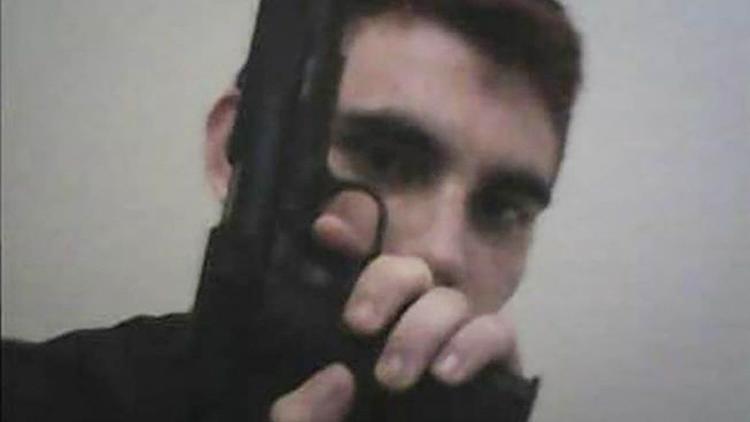 The militarization of public schools is a subject concerning the life and death of the young people of this country and those millions across the globe they will be trained to kill, torture, and invade. To speak of this is to challenge the intense economic, social and cultural campaigns conducted to convince populations that wars benefiting the rich are wars guaranteeing freedom. The increasing need for young people to voluntarily join the US military to fight the wars for the enforcement of global capitalism as it expands its markets poses a challenge for radical educators to provide alternative scenarios. This article examines this agenda for militarization and provides strategies for counter-campaigns to end militarization in the public schools and the culture at large.
The militarization of public schools is a subject concerning the life and death of the young people of this country and those millions across the globe they will be trained to kill, torture, and invade. To speak of this is to challenge the intense economic, social and cultural campaigns conducted to convince populations that wars benefiting the rich are wars guaranteeing freedom. The increasing need for young people to voluntarily join the US military to fight the wars for the enforcement of global capitalism as it expands its markets poses a challenge for radical educators to provide alternative scenarios. This article examines this agenda for militarization and provides strategies for counter-campaigns to end militarization in the public schools and the culture at large.





 Campus spies. Pepper spray. SWAT teams. Twitter trackers. Biometrics. Student security consultants. Professors of homeland security studies. Welcome to Repress U, class of 2012.
Campus spies. Pepper spray. SWAT teams. Twitter trackers. Biometrics. Student security consultants. Professors of homeland security studies. Welcome to Repress U, class of 2012.
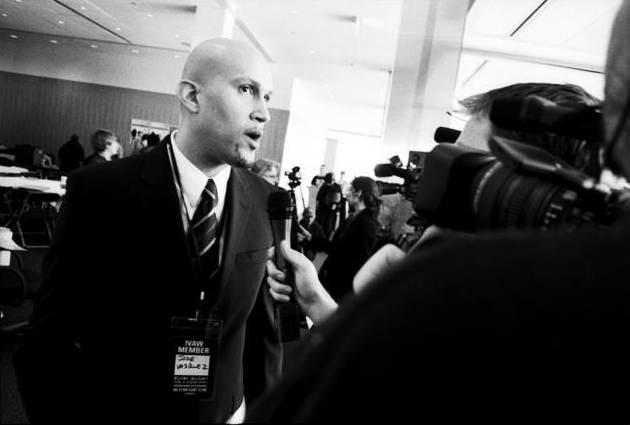 March 19th marked the sad anniversary of the U.S. invasion of Iraq. Nine tumultuous years after "shock and awe," the people of Iraq struggle to rebuild their society while dealing with the aftermath of a disastrous occupation. When the last combat brigades pulled out in December 2011, putting Iraq in their rear-view mirrors, what was the legacy they left in their wake and the burdens they brought home with them?
March 19th marked the sad anniversary of the U.S. invasion of Iraq. Nine tumultuous years after "shock and awe," the people of Iraq struggle to rebuild their society while dealing with the aftermath of a disastrous occupation. When the last combat brigades pulled out in December 2011, putting Iraq in their rear-view mirrors, what was the legacy they left in their wake and the burdens they brought home with them?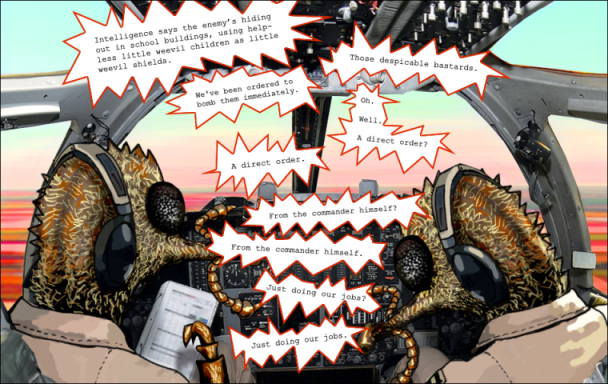 ‘Weapons are tools not just of destruction but also of perception - that is to say, stimulants that make themselves felt through chemical, neurological processes in the sense organs and the central nervous system, affecting human reactions and even the perceptual identification and differentiation of objects.’
‘Weapons are tools not just of destruction but also of perception - that is to say, stimulants that make themselves felt through chemical, neurological processes in the sense organs and the central nervous system, affecting human reactions and even the perceptual identification and differentiation of objects.’